This article is part of our Pets special section on scientists’ growing interest in our animal companions.
Every dog has its day, and July 14, 2004, belonged to a boxer named Tasha. On that date, the National Institutes of Health announced that the barrel-chested, generously jowled canine had become the first dog to have her complete genome sequenced. “And everything has kind of exploded since then,” said Elaine Ostrander, a canine genomics expert at the National Human Genome Research Institute, who was part of the research team.
In the 20 years since, geneticists have fallen hard for our canine companions, sequencing thousands upon thousands of dogs, including pedigreed purebreds, mysterious mutts, highly trained working dogs, free-ranging village dogs and even ancient canine remains.
Research on canine cognition and behavior has taken off, too. “Now dog posters are taking up half of an animal behavior conference,” said Monique Udell, who directs the human-animal interaction lab at Oregon State University. “And we’re starting to see cat research following that same trend.”
Just a few decades ago, many researchers considered pets to be deeply unserious subjects. (“I didn’t want to study dogs,” said Alexandra Horowitz, who has since become a prominent researcher in the field of canine cognition.) Today, companion animals are absolutely in vogue. Scientists around the world are peering deep into the bodies and minds of cats and dogs, hoping to learn more about how they wriggled their way into our lives, how they experience the world and how to keep them living in it longer. It’s a shift that some experts say is long overdue.
“We have a responsibility to deeply understand these animals if we’re going to live with them,” Dr. Udell said. “We also have this great potential to learn a lot about them and a lot about ourselves in the process.”
Pet projects
For geneticists, dogs and cats are both rich subjects, given their long, close history with humans and their susceptibility to many of the same diseases, from cancer to diabetes.







